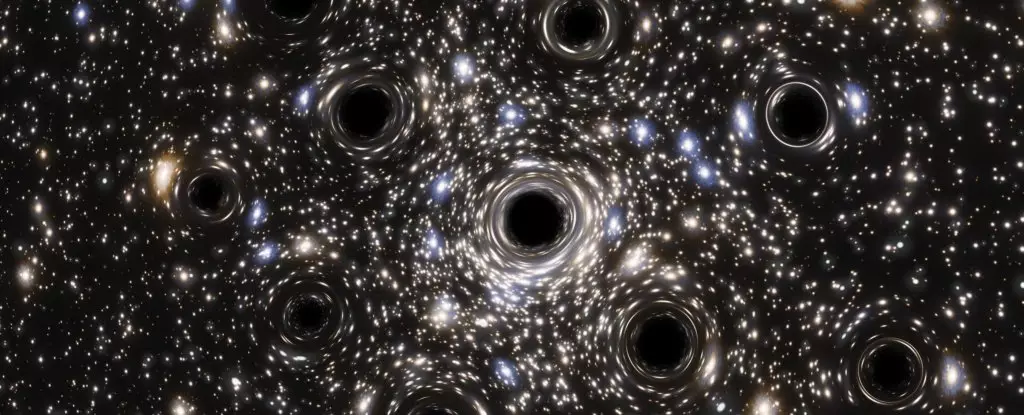In the vast expanse of the cosmos, clusters of stars offer profound insights into the evolution of our universe. Among these clusters is Palomar 5, a unique stellar stream that not only captivates astronomers but also challenges existing theories about black holes within globular clusters. Spanning an impressive 30,000 light-years and positioned approximately 80,000 light-years away from Earth, Palomar 5 has emerged as a pivotal subject of research, shedding light on the dynamics of star formation and the nature of dark matter in the universe.
Globular clusters serve as vital ‘fossils’ from the early universe, providing a snapshot of stellar evolution and cosmic history. These dense, spherical formations typically contain between 100,000 to 1 million old stars, making them key players in studying the universe’s composition. For instance, the globular cluster NGC 6397 is nearly as ancient as the universe itself, emphasizing the historical significance of these formations. The Milky Way is home to around 150 recognized globular clusters, each acting as a valuable resource for astronomers aiming to comprehend the universe’s past and the underlying structure of galaxies.
However, the focus on traditional globular clusters is evolving. Emerging research highlights tidal streams—elongated rivers of stars that provide further context for the gravitational interactions within galaxies. While traditionally challenging to identify, new mapping efforts from the Gaia space observatory have brought these streams into focus. The connection between these streams and their associated star clusters remains enigmatic, prompting astrophysicists to seek out unique cases like Palomar 5, which offers a remarkable opportunity to explore the formation dynamics of tidal streams.
Palomar 5 stands out due to its expansive distribution of stars and its notably extensive tidal stream, which stretches for over 20 degrees in the sky. With its distinctive characteristics, Palomar 5 has become a focal point for researchers seeking to understand the origins of tidal streams in the context of globular clusters. Mark Gieles, an astrophysicist from the University of Barcelona, underscored the importance of studying Palomar 5, stating that it acts as a “Rosetta Stone” for understanding the complexities of stream formation.
The innovative approach taken by researchers involved detailed N-body simulations, which enabled them to recreate the paths and evolutionary trajectories of Palomar 5’s stars. By simulating various scenarios, scientists could analyze how these stars migrated within the cluster, providing vital clues to the process behind tidal stream formation. Crucially, recent evidence has suggested that significant populations of black holes could exist in the centers of globular clusters, leading researchers to integrate black hole dynamics into their simulations.
The simulation findings yielded surprising conclusions: the presence of stellar-mass black holes within Palomar 5 could explain the formation of its tidal stream. The interactions between celebrating stars and these black holes demonstrated the potential for stars to be “slingshot” away from the cluster, highlighting the profound influence of gravitational forces. However, the simulations indicated that the concentration of black holes in Palomar 5 is substantially higher than previously expected—roughly three times the amount anticipated based on stellar ratios.
Gieles elaborated on this revelation, stating that over 20 percent of Palomar 5’s total mass comprises black holes, each possessing a mass equivalent to about 20 times that of our Sun. These black holes were formed during supernova explosions in the aftermath of massive stars reaching the end of their life cycles, a process that occurred when the cluster was still in its formative stages. Not only does this finding deepen our understanding of Palomar 5, but it also raises thought-provoking questions about the ultimate fate of other globular clusters within the Milky Way.
Projected outcomes from the simulations suggest that within a billion years, Palomar 5 will eventually dissolve entirely, leaving behind a cluster predominantly composed of black holes orbiting the galaxy’s center. This tantalizing conclusion implies that Palomar 5’s destiny is not an isolated case. Researchers now suspect that many globular clusters may share a similar fate, becoming stellar streams as black holes gradually influence their gravitational structure.
Moreover, this dissolution reinforces the notion that globular clusters could serve as promising environments for detecting black holes. As highlighted by astrophysicist Fabio Antonini, many binary black hole mergers are believed to occur within star clusters, making them crucial targets for future observational studies.
The study of Palomar 5 exemplifies the interconnected nature of black holes and stellar evolution in our universe. As researchers continue to unravel the mysteries contained within this unique star cluster, they not only advance our understanding of cosmic history but also illuminate the intricacies of gravitational dynamics and dark matter distributions. The ongoing work surrounding Palomar 5 is a testament to humanity’s enduring quest to decipher the secrets of the cosmos, reminding us that the universe is an ever-evolving tapestry woven with countless stories waiting to be discovered.


Leave a Reply